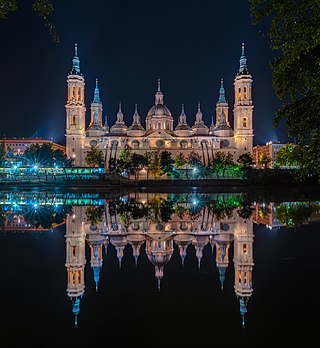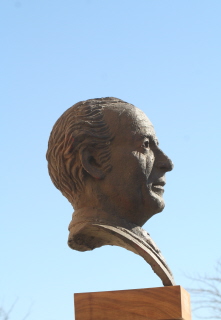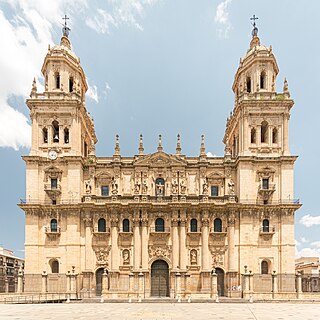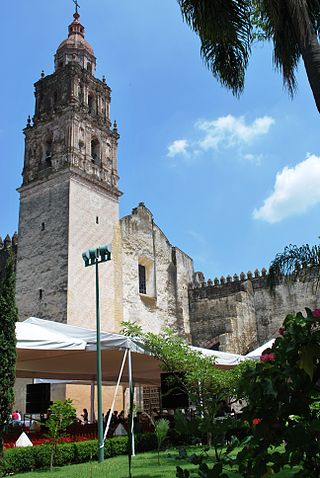Baja California

The Misión Santa Gertrudis was founded in 1751.
The following is a list of the oldest extant church in each of the administrative divisions of Mexico. The first place of Christian worship in what would become Mexico was in what is now known as La Antigua, Veracruz, founded by the Spanish in 1519.
The Catedral de Aguascalientes completed in 1738. This cathedral is built on the site of a chapel founded in 1575. [1]

The Misión Santa Gertrudis was founded in 1751.

The Misión de Nuestra Señora de Loreto Conchó founded on 25 October 1697 is considered the "head and mother of all the Spanish missions in Alta and Baja California".
The oldest mission in the Californias was the short-lived Misión San Bruno, established in 1683.
In 1540, a church in honor of the Virgen de la Purísima Concepción was begun and it was built upon until 1650. It was expanded between 1758 and 1760. Another tower was added in 1850 and it was elevated to Catedral de Campeche in 1895 during the establishment of the Diocese of Campeche.

The Templo de Santo Domingo de Guzmán in Chiapa de Corzo began construction in 1554.

The Templo de San Francisco de Asís, built between 1721 and 1741, is the oldest religious building in Chihuahua City.


The Templo de San Esteban dates to 1591. [2]
The Catedral Basílica Menor de Colima. It has a precursor in a building constructed of wood in 1525.
The Templo de San Francisco was completed in 1563. [3] The building was partially ruined, but INAH approved its refurbishment. It is located in Nombre de Dios, the first settlement in Durango.
The Parroquia de San Francisco in Acambaro dates to 1532. [4]


The cathedral of Chilapa has a predecessor from at the very least 1533. [5]
The Capilla de la Expiración in Tulancingo dates to 1526. [6]

The Guadalajara Cathedral has a predecessor built on the same site in 1541.
The Catedral de Texcoco has antecedents beginning in 1526.

The Iglesia de la Inmaculada Concepción in Coyoacán began construction in 1525.
The Capilla de Santa María Magdalena in Tacámbaro is from 1538.
Construction on the Cuernavaca Cathedral began in 1529. The building forms part of the World Heritage site Earliest 16th-Century Monasteries on the Slopes of Popocatépetl .
The Templo de Santiago de Compostela has antecedents in the 16th century.
The Capilla de Doña Mónica Rodríguez in San Pedro Garza García dates to 1661.
The Templo y Exconvento de San Juan de Dios was completed in 1703. This is where the first mass in Oaxaca was held in 1521.

The Convento de San Miguel Arcángel began construction in 1524 and is the oldest of the Monasteries on the slopes of Popocatépetl.
The Iglesia Chiquita in El Marqués dates to 1529. [7] It was founded following the conversion of Otomi leader Conín to Christianity.
| | This section needs expansion. You can help by adding to it. (February 2016) |
The Exconvento de San Agustín in Xilitla is from 1557. [8]


The Parroquia de Nuestra Señora del Rosario from 1731.
The Mission San Pedro y San Pablo del Tubutama founded in 1691 by Father Eusebio Francisco Kino.
The first mission was the Mission Nuestra Señora de los Dolores founded in 1687.
The Iglesia de Nuestra Señora de la Asunción in Tacotalpa was completed in 1710.
The Iglesia de Nuestra Señora de Las Nieves in Palmillas dates to 1777. [9]

Construction on what would become the Catedral de Tlaxcala occurred in the 1530s.
The Parroquia de San José in Xalapa is from 1535.
The Catedral de Yucatán was built between 1562 and 1599.
The Zacatecas Cathedral was preceded by two temples, one that began construction in 1568 and another in 1625.


Aristide Cavaillé-Coll was a French organ builder. He has the reputation of being the most distinguished organ builder of the 19th century. He pioneered innovations in the art and science of organ building that permeated the profession and influenced the course of organ building, composing and improvising through the early 20th century.

The Cathedral-Basilica of Our Lady of the Pillar is a Catholic church in the city of Zaragoza, Aragon (Spain). The basilica's titular is the Blessed Virgin Mary under the title of Our Lady of the Pillar, praised as "Mother of the Hispanic Peoples" by Pope John Paul II.

Juan Caballero y Ocio was a priest remarkable for lavish gifts to the Catholic church and for charity.

The Catholic Church in Puerto Rico is part of the worldwide Catholic Church in communion with the pope in Rome. The 78 municipalities in Puerto Rico have a Catholic church which is located in the downtown area, normally across from the central plaza.

The Metropolitan Cathedral of the Assumption of the Most Blessed Virgin Mary into Heaven, also commonly called the Mexico City Metropolitan Cathedral, is the cathedral church of the Catholic Archdiocese of Mexico. It is situated on top of the former Aztec sacred precinct near the Templo Mayor on the northern side of the Plaza de la Constitución (Zócalo) in the historic center of Mexico City. The cathedral was built in sections from 1573 to 1813 around the original church that was constructed soon after the Spanish conquest of Tenochtitlan, eventually replacing it entirely. Spanish architect Claudio de Arciniega planned the construction, drawing inspiration from Gothic cathedrals in Spain.

El Camino Real de Tierra Adentro, also known as the Silver Route, was a Spanish 2,560-kilometre-long (1,590 mi) road between Mexico City and San Juan Pueblo, New Mexico, that was used from 1598 to 1882. It was the northernmost of the four major "royal roads" that linked Mexico City to its major tributaries during and after the Spanish colonial era.

The Spanish missions in Baja California were a large number of religious outposts established by Catholic religious orders, the Jesuits, the Franciscans and the Dominicans, between 1683 and 1834. The missionary goal was to spread the Christian doctrine among the Indigenous peoples living on the Baja California peninsula. The missions gave Spain a valuable toehold in the frontier land, and would also act as a deterrent to prevent pirates from using the peninsula of Las Californias as a jumping off point for contraband trade with mainland New Spain. Missionaries introduced European livestock, fruits, vegetables, and industry into the region. Indigenous peoples were severely impacted by the introduction of European diseases such as smallpox and measles; furthermore, the expulsion of the Jesuits from the Spanish Empire in 1767 ripped the social fabric of the peninsula, although Franciscans were sent to replace them. In 1769, the Franciscans moved to Upper California, leaving Dominicans in charge of Baja California. By 1800 indigenous numbers were a fraction of what they had been before the arrival of the Spanish, yet even today many people living in Baja California are of indigenous heritage.

The Basilica of Guadalupe or Santuario de Nuestra Señora de Guadalupe is a Roman Catholic church located in the metropolitan area of Monterrey, Nuevo León, Mexico.

Antonio León Ortega was a Spanish sculptor known for his Andalusian imagery.

The Assumption of the Virgin Cathedral is a Renaissance-style, Roman Catholic cathedral located in Santa María Square, opposite the Town Hall and the Episcopal Palace, in the center of Jaén, region of Andalusia, Spain.

The Cathedral of Our Lady of the Assumption, located in the city of Oaxaca de Juarez, Oaxaca, Mexico, is the seat of the Roman Catholic Archdiocese of Antequera, Oaxaca. Its construction began circa 1535 and it was consecrated on 12 July 1733. It is dedicated to Our Lady of the Assumption.

The Cuernavaca Cathedral is the Roman Catholic church of the Diocese of Cuernavaca, located in the city of Cuernavaca, Morelos, Mexico. The church and its surrounding monastery is one of the early 16th century monasteries in the vicinity of the Popocatepetl volcano inscribed as a World Heritage Site by UNESCO, built initially for evangelization efforts of indigenous people after the Spanish conquest of the Aztec Empire. By the 18th century, the church of the monastery began to function as the parish church of the city and in the late 19th century, it was elevated to the rank of a cathedral. Unlike many cathedrals in Mexico, this one does not face the city's main square, but rather is located just to the south, in its own walled compound, which it shares with a number of other structures. Unlike the other monastery structures from its time, the importance of this church provoked a number of renovation projects, the last of which occurred in 1957. This one took out the remaining older decorations of the interior and replaced them with simple modern ones. This renovation work also uncovered a 17th-century mural that covers 400 square metres (4,300 sq ft) of the interior walls and narrates the story of Philip of Jesus and twenty three other missionaries who were crucified in Japan.

A national shrine is a Catholic church or other sacred place which has met certain requirements and is given this honor by the national episcopal conference to recognize the church's special cultural, historical, and religious significance.

The Cathedral of Our Lady of Guadalupe is the main Roman Catholic church building of Canelones, Uruguay. It is the see of the Roman Catholic Diocese of Canelones since 1961.
Nuestra Señora is Spanish for Mary, mother of Jesus.

The Church and Convent of San Nicolás de Tolentino is the Catholic church and parish house of the people of Actopan. It has always belonged to the Diocese of Tulancingo in Mexico. This church is located in the center of city. This colonial building is a monument of great architectural importance which has lasted until today in the State of Hidalgo.

The Cathedral of Our Lady of the Assumption, also Tlaxcala de Xicohténcatl Cathedral, is the main Catholic church in the city of Tlaxcala, Mexico. It was first known as the Temple of St. Francis of Assisi, however, when the Diocese began to rise, it was decided to name the cathedral and as it is commonly known; Dedicated as a cathedral under the invocation of Our Lady of the Assumption during the erection of the diocese of Tlaxcala.

Holy Week in San Cristóbal de La Laguna is a traditional event that has been repeated for centuries in the historic center of San Cristóbal de La Laguna, a city located on the island of Tenerife, Spain. It is considered the most remarkable Holy Week in the Canary Islands.